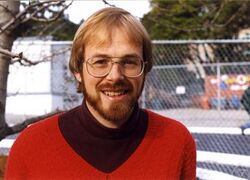Biography:Richard Taylor (mathematician)
Richard Taylor | |
|---|---|
 Taylor in 1999 | |
| Born | Richard Lawrence Taylor 19 May 1962 Cambridge, England |
| Nationality | British, American |
| Alma mater | Clare College, Cambridge (BA) Princeton University (PhD) |
| Spouse(s) | Christine Taylor[citation needed] |
| Awards | Whitehead Prize (1990) Fermat Prize (2001) Ostrowski Prize (2001) Cole Prize (2002) Shaw Prize (2007) Clay Research Award (2007) Breakthrough Prize in Mathematics (2015) |
| Scientific career | |
| Fields | Mathematics |
| Institutions | University of Oxford Harvard University Institute for Advanced Study Stanford University |
| Thesis | On congruences between modular forms (1988) |
| Doctoral advisor | Andrew Wiles |
| Doctoral students |
|
Richard Lawrence Taylor (born 19 May 1962) is a British[2] mathematician working in the field of number theory.[3] He is currently the Barbara Kimball Browning Professor in Humanities and Sciences at Stanford University.[4]
Taylor received the 2015 Breakthrough Prize in Mathematics "for numerous breakthrough results in the theory of automorphic forms, including the Taniyama–Weil conjecture, the local Langlands conjecture for general linear groups, and the Sato–Tate conjecture."[5] He also received the 2007 Shaw Prize in Mathematical Sciences for his work on the Langlands program with Robert Langlands. He also served on the Mathematical Sciences jury for the Infosys Prize from 2012 to 2014.
Career
He received his B.A. from Clare College, Cambridge.[6][7] During his time at Cambridge, he was president of The Archimedeans in 1981 and 1982, following the resignation of his predecessor.[8] He earned his Ph.D. in mathematics from Princeton University in 1988 after completing a doctoral dissertation, titled "On congruences between modular forms", under the supervision of Andrew Wiles.[9] From 1995 to 1996 he held the Savilian chair of geometry[6] at Oxford University and Fellow of New College, Oxford,[7] and later became the Herchel Smith Professor of Mathematics at Harvard University, and held the Robert and Luisa Fernholz Professorship at the Institute for Advanced Study. He is currently the Barbara Kimball Browning Professor in Humanities & Sciences at Stanford University.[4]
He received the Whitehead Prize in 1990, the Fermat Prize and the Ostrowski Prize in 2001, the Cole Prize of the American Mathematical Society in 2002, and the Shaw Prize for Mathematics in 2007. He was also elected a Fellow of the Royal Society in 1995. In 2012 he became a fellow of the American Mathematical Society.[10] In 2015 he was inducted into the National Academy of Sciences.[11] He was elected to the American Philosophical Society in 2018.[12]
Research
One of the two papers containing the published proof of Fermat's Last Theorem is a joint work of Taylor and Andrew Wiles.[13]
In subsequent work, Taylor (along with Michael Harris) proved the local Langlands conjectures for GL(n) over a number field.[14] A simpler proof was suggested almost at the same time by Guy Henniart,[15] and ten years later by Peter Scholze.
Taylor, together with Christophe Breuil, Brian Conrad and Fred Diamond, completed the proof of the Taniyama–Shimura conjecture, by performing quite heavy technical computations in the case of additive reduction.[16]
In 2008, Taylor, following the ideas of Michael Harris and building on his joint work with Laurent Clozel, Michael Harris, and Nick Shepherd-Barron, announced a proof of the Sato–Tate conjecture, for elliptic curves with non-integral j-invariant. This partial proof of the Sato–Tate conjecture uses Wiles's theorem about modularity of semistable elliptic curves.[17]
Personal life
Taylor is the son of British physicist John C. Taylor. He is married, and has two children.[18]
References
- ↑ Richard Taylor at the Mathematics Genealogy Project
- ↑ "Member Directory: Richard L. Taylor". National Academy of Science. http://www.nasonline.org/member-directory/members/20035967.html.
- ↑ Carayol, Henri (1999), "Preuve de la conjecture de Langlands locale pour GLn: travaux de Harris–Taylor et Henniart" (in fr), Séminaire Nicolas Bourbaki: 191–243, http://www.numdam.org/item?id=SB_1998-1999__41__191_0
- ↑ 4.0 4.1 Taylor's staff page at Stanford.
- ↑ "Breakthrough Prize". Breakthrough Prize. https://breakthroughprize.org/?controller=Page&action=laureates&p=3&laureate_id=59.
- ↑ 6.0 6.1 SAVILIAN PROFESSORSHIP OF GEOMETRY in NOTICES, University Gazette 23.3.95 No. 4359 [1]
- ↑ 7.0 7.1 'TAYLOR, Prof. Richard Lawrence', Who's Who 2008, A & C Black, 2008; online edn, Oxford University Press, Dec 2007 accessed 27 March 2008
- ↑ "List of Presidents of The Archimedeans". https://www.archim.org.uk/committees/archimedeans/presidents.txt.
- ↑ Taylor, Richard Lawrence (1988) (in en). On congruences between modular forms. https://catalog.princeton.edu/catalog/449433.
- ↑ List of Fellows of the American Mathematical Society. Retrieved 25 August 2013.
- ↑ National Academy of Sciences Member Directory. Retrieved 30 April 2016.
- ↑ "Election of New Members at the 2018 Spring Meeting | American Philosophical Society". https://www.amphilsoc.org/blog/election-new-members-2018-spring-meeting.
- ↑ Taylor, R.; Wiles, A. (1995). "Ring theoretic properties of certain Hecke algebras". Ann. of Math. 141 (3): 553–572. doi:10.2307/2118560.
- ↑ Harris, M.; Taylor, R. (2001). The geometry and cohomology of some simple Shimura varieties. Annals of Mathematics Studies. 151. Princeton University Press. ISBN 978-0-691-09090-0.
- ↑ Carayol 1999, pp. 193–194
- ↑ Breuil, C.; Conrad, B.; Diamond, F.; Taylor, R. (2001). "On the modularity of elliptic curves over Q: wild 3-adic exercises". J. Amer. Math. Soc. 14 (4): 843–939. doi:10.1090/S0894-0347-01-00370-8.
- ↑ Taylor, R. (2008). "Automorphy for some l-adic lifts of automorphic mod l representations. II". Publications Mathématiques de l'IHÉS 108 (1): 183–239. doi:10.1007/s10240-008-0015-2.
- ↑ Taylor, Richard "The Shaw Prize", 2007
External links
- His home page at the Institute for Advanced Study
- Richard Taylor at the Mathematics Genealogy Project
- Autobiography upon Shaw Prize acceptance
 |

